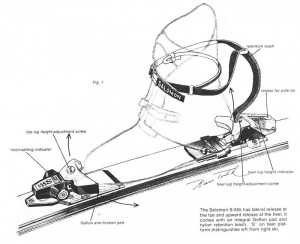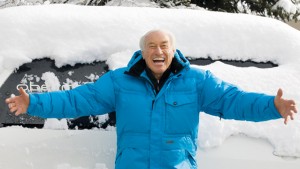It was sometime in March 1967 and I was skiing at Mount Whittier in New Hampshire. I had reached the “learn-to-ski-moguls-or-die” stage in my quest to be an expert skier. I was on a mogul run and found myself going faster and faster. The inevitable happened and I fell spectacularly. Both of my bindings released as they should have and I became a flailing ball of snow and equipment.
Once I finally came to a stop, I got up and started the process of putting my skis back on. I noticed some blood in the snow and thought “Hmm? Somebody’s bleeding.” Just then a couple more drops of blood fell onto the white snow. That somebody was me!
 My skis were attached to me with safety straps that kept the skis from running away, but that meant that during a fall the skis could swing wildly and flog you. One of my ski edges struck me in the head and produced about a three-quarters-of-an-inch cut in my scalp. Scalp wounds tend to bleed a lot so there I was standing on the slope with blood running down my face.
My skis were attached to me with safety straps that kept the skis from running away, but that meant that during a fall the skis could swing wildly and flog you. One of my ski edges struck me in the head and produced about a three-quarters-of-an-inch cut in my scalp. Scalp wounds tend to bleed a lot so there I was standing on the slope with blood running down my face.
I put my skis on and hurried down to the ski patrol room at the base of the slope. I panicked the woman patroller on duty who apparently wasn’t prepared for someone dripping blood to walk through the door. She recovered quickly and cleaned me up to find the scalp cut, but now the challenge became how to put a bandage on it. She wanted to cut some of my hair, but this was the 1960s and hair was important to me. (It would still be important to me today, if I had any!) The head of the ski patrol then appeared. He assessed the situation and asked if I had a ski hat which I did. He put a gauze pad on my cut and we pulled my ski hat tightly down over it. I went back out to ski for the rest of the day.
How do you keep a ski from running away when a binding releases? For a lot of years we used some sort of retention device, a “safety strap,” that attached the ski to your leg. This led to a new set of injuries like mine, but in most cases they were less severe than a broken leg.
The simplest safety strap was just a short leather strap hooked to the binding which you clipped to your boot laces. These had a tendency to break in violent falls producing the very thing they were supposed to prevent: a runaway ski. Then there were the Arlberg straps which were a shorter version of the long-thong. These wrapped around the ski boot and then buckled. These did hold the ski more reliably, but as step-in bindings became more popular, they were inconvenient. In 1967 I had a Salomon leash which attached to the binding and clipped around your leg.
 In the early 1960s rivals Earl Miller and Mitch Cubberley both introduced the first ski brakes to eliminate the need for safety straps. Theirs were single bladed brakes and didn’t catch on for a variety of reasons. It wasn’t until 1974 that Klaus Obermeyer would introduce the first two-pronged ski brake to the United States. Called the Ski Stopper, Obermeyer imported them from Italy. They had such strong springs that lighter skiers could be ejected from their bindings when unweighting! By the way, Klaus Obermeyer lives in Aspen and still skis at age 95!
In the early 1960s rivals Earl Miller and Mitch Cubberley both introduced the first ski brakes to eliminate the need for safety straps. Theirs were single bladed brakes and didn’t catch on for a variety of reasons. It wasn’t until 1974 that Klaus Obermeyer would introduce the first two-pronged ski brake to the United States. Called the Ski Stopper, Obermeyer imported them from Italy. They had such strong springs that lighter skiers could be ejected from their bindings when unweighting! By the way, Klaus Obermeyer lives in Aspen and still skis at age 95!
Tucky Murphy was the only one to identify Obermeyer as the first to introduce the two-pronged brake.
Ski areas here in the United States were slow to accept ski brakes. There were concerns about the brakes’ effectiveness. There was also the potential for a ski to come off while riding a lift and fall on someone below. Killington defined a policy, articulated by its marketing director, Foster Chandler, that you could use ski brakes at Killington, but you needed safety straps as well. This policy was adopted by most U.S. ski areas.
By 1978 all the major binding companies were providing two-pronged ski brakes. Europe was allowing brakes on their slopes – without the additional safety straps. Eventually the U.S. areas would modify their policies as well.
I don’t remember when I got my first ski brakes. I do remember they were under the toe piece with the prongs facing forward, a bad design choice. Skiing through some of the bushes in the Birthday Bowls, one of my brakes hooked a twig basically stopping the ski. I came out of the binding and crashed into the bushes which left me uninjured, but shaken.

March 25, 2015 at 1:01 pm
Hi, Greg! I love all this history. I grew up in the Pocono mountains and could ski pretty much since I could walk:)
P.S. A friend giving away a 4 pack of ski passes to Killington Resort on her blog in case you know anyone who is interested (the link is in the bio). There is low entries. It ends 3/29. Hope this is OK , thought maybe some of your readers may be interested in entering, too.
October 3, 2016 at 5:28 pm
I have had straps on my skis since 1972 and never had the skis clobber me if I went from vertical to horizontal on the slope. and when I did pick myself up and put the skis back on, they were right there and not halfway down the slope.
November 11, 2018 at 7:05 am
I was just talking to someone about safety straps at dinner tonight. In 1971, at the age of 5, I was on the ropetow (look it up for those who don’t know). When no one was close to me, I could not hold up the rope. My knuckles would drag in the snow. One time the safety strap wrapped around the rope. When I got to the top and tried to push away… yep, I got pulled up in the air hanging from my safety strap while I headed for the wheel house. Lucky for me the lift operator was quick enough to shut the lift down before I ended up with my leg crushed.
A cup of hot chocolate later and I was ready to hit the slopes again.
November 11, 2018 at 7:09 am
When I got older and better, the problem was the straps were too short. Loose your ski in the powder and it was hell trying to put them back on. More times than I could count, I had to climb out of a tree well so I could put my skis on. Thank god for breaks.
March 11, 2021 at 7:53 am
You have done a great job writing this article to keep us informed.
https://osroe.com
January 12, 2022 at 8:39 am
I am always telling my cross country ski touring friends to use ski leashes. I believe they use them in northern Europe where touring in the backcountry on rolling terrain is a popular pastime (and less so than it used to be in the U.S.A.). While most cross country ski touring bindings are not designed to be releasable (Voile did used to make them), it is still possible for the bail or spring-loaded retaining clip to come undone in a fall. Without a leash, that thin ski is like a missle flying down even a moderate slope, possibly hitting someone skiing up the trail; and good luck finding it. The NNN BC cross country bindings usually come with a leash plate that mounts under the front of the binding, but most people don’t use them. With old school 3-pin bindings it is easy to attach a key ring to the bail or binding body for the leash to clip to – lots of ways to improvise. I usually wind up making them for firends out out of nylon webbing, metal rings, and spring clips. While most leashes that you can still buy are made of thin metal cable, I like using nylon webbing with strong nylon thread to make them. The reason for this is that you might have to cut the leash with a pocket knife in an emergency.
October 6, 2023 at 3:08 am
Still think runaway straps would be great for powder skiing.
November 3, 2023 at 10:36 pm
Where Dani buy some old style safety straps. Rick
January 7, 2024 at 11:56 pm
During the 1970s before US slopes began to permit ski brakes, I helped test an alternate to leather safety straps called the Quik-in. It was a stiff but springy cord that ran between the boot and binding, so the ski remaining tethered. A skier could snap the cord in and out via a simple foot movement that took about one second. When riding a gondola, this device was much easier than repeated removal and reaffixing of leather straps with cold fingers. Brakes were easier to install, so once they were allowed, they become common.